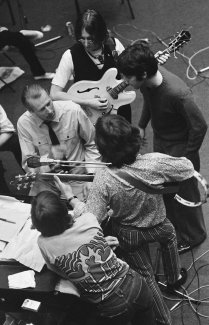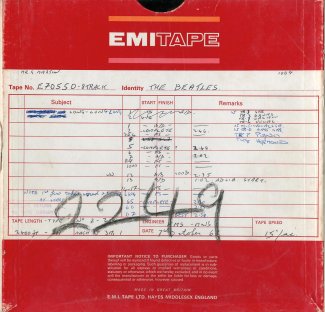News - 24 September 2018
The Beatles (White Album) - The Anniversary Editions - The Recording
Much of the initial songwriting for 'The White Album' was done in Rishikesh, India between February and April 1968, when John Lennon, Paul McCartney, George Harrison, and Ringo Starr joined a course at the Maharishi's Academy of Transcendental Meditation. In a postcard to Ringo, who had returned to England before the others, John wrote, "we've got about two L.P.s worth of songs now so get your drums out."
During the last week of May, The Beatles gathered at George's house in Esher, Surrey, where they recorded acoustic demos for 27 songs. Known as the Esher Demos, all 27 recordings are included in the new edition's Deluxe and Super Deluxe packages, sourced from the original four-track tapes. Twenty-one of the demoed songs were recorded during the subsequent studio sessions, and 19 were ultimately finished and included on 'The White Album.'
The Beatles' studio sessions for The BEATLES ('White Album') began on May 30, 1968 at Abbey Road Studios. In the 20 weeks that followed, The Beatles devoted most of their time to sessions there for the new album, with some recording also done at Trident Studios. The final session for the album took place at Abbey Road on October 16, a 24-hour marathon with producer George Martin to sequence the double album's four sides and to complete edits and cross-fades between its songs. The Beatles' approach to recording for 'The White Album' was quite different from what they had done for 'Sgt. Pepper.' Rather than layering individually overdubbed parts on a multi-track tape, many of the 'White Album' session takes were recorded to four-track and eight-track tape as group performances with a live lead vocal. The Beatles often recorded take after take for a song, as evidenced by the Super Deluxe set's Take 102 for "Not Guilty," a song that was not included on the album. This live-take recording style resulted in a less intricately structured, more unbridled album that would shift the course of rock music and cut a path for punk and indie rock.



The Beatles' newly adopted method of recording all through the night was time consuming and exhausting for their producer, George Martin. Martin had other duties, including his management of AIR (Associated Independent Recording), and he had also composed the orchestral score for The Beatles' animated feature film, Yellow Submarine, released in July 1968. After the first three months of 'White Album' sessions, Martin took a three-week holiday from the studio, entrusting the control room to his young assistant Chris Thomas and balance engineer Ken Scott. Scott had taken the place of engineer Geoff Emerick, who left the sessions in mid-July. On August 22, Ringo Starr also left the sessions, returning 11 days later to find his drum kit adorned with flowers from his bandmates. While the sessions' four and a half months of long hours and many takes did spark occasional friction in the studio, the session recordings reveal the closeness, camaraderie, and collaborative strengths within the band, as well as with George Martin.
The BEATLES ('White Album') was the first Beatles album to be released on the group's own Apple Records label. Issued in both stereo and mono for the U.K. and in stereo for the U.S., the double album was an immediate bestseller, entering the British chart at number one and remaining there for eight of the 22 weeks it was listed. 'The White Album' also debuted at number one on the U.S. chart, holding the top spot for nine weeks of its initial 65-week chart run. In his glowing 'White Album' review for Rolling Stone, the magazine's co-founder Jann Wenner declared: "It is the best album they have ever released, and only The Beatles are capable of making a better one." In the U.S., 'The White Album' is 19-times platinum-certified by the RIAA and in 2000, it was inducted into the Recording Academy's GRAMMY(R) Hall of Fame, recognizing "recordings of lasting qualitative or historical significance."


Share this website